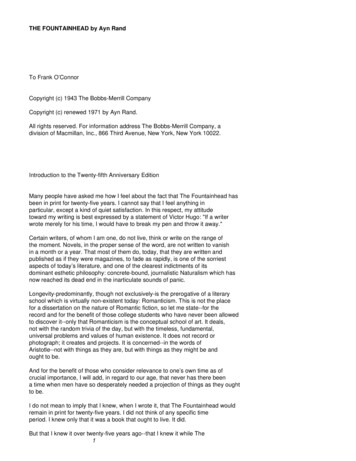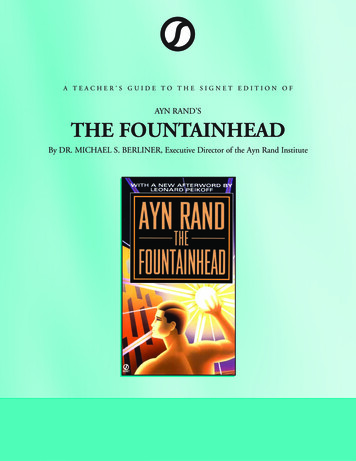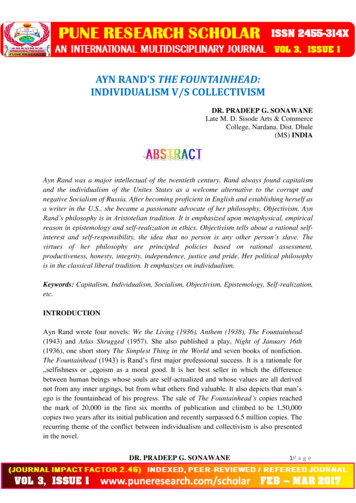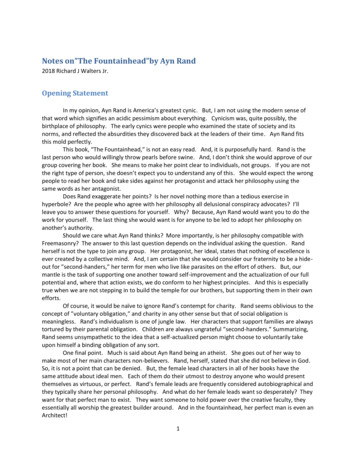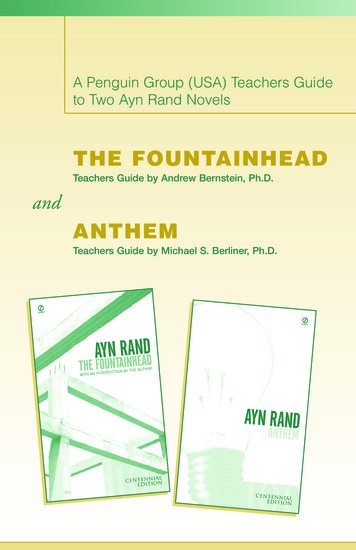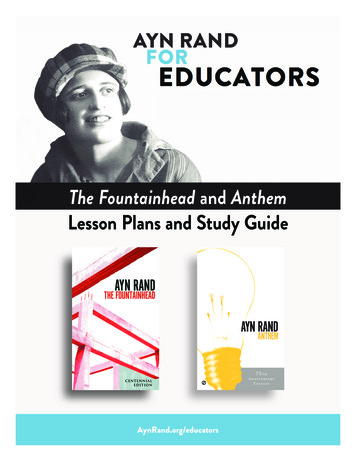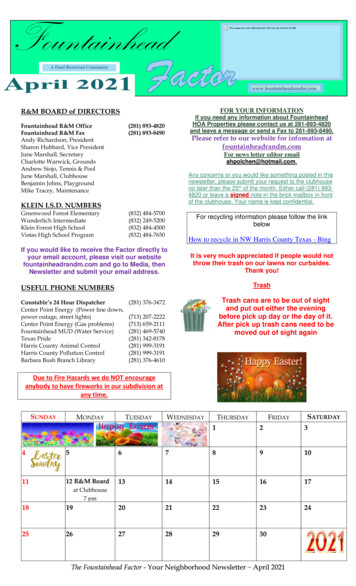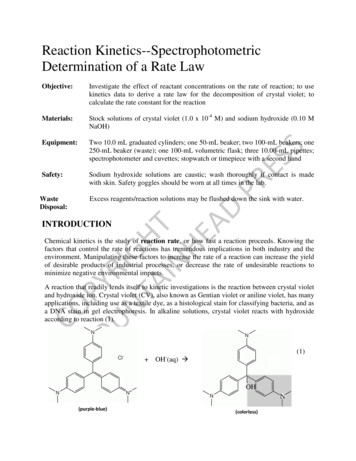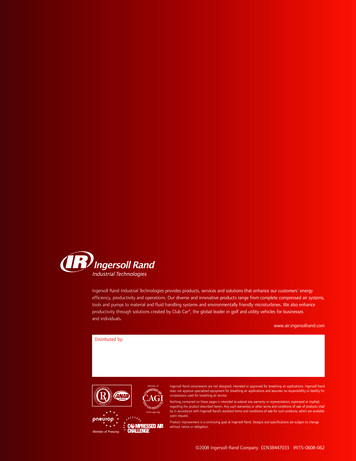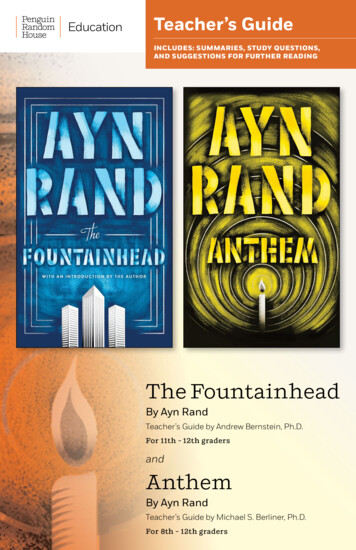
Transcription
Teacher’s GuideINCLUDES: SUMMARIES, Study QUESTIONS,AND SUGGESTIONS FOR FURTHER READINGThe FountainheadBy Ayn RandTeacher’s Guide by Andrew Bernstein, Ph.D.For 11th – 12th gradersandAnthemBy Ayn RandTeacher’s Guide by Michael S. Berliner, Ph.D.For 8th – 12th graders
2A Teacher’s Guide to The Fountainhead and Anthem by Ayn RandTable of ContentsThe FountainheadAbout Ayn Rand.3Introduction.3Principal Characters.4The Climax of the Novel.7Philosophical Themes in Roark’s Speech.7Suggested Study Questions.9Further Resources. 10Essay Contests. 10About the Author of This Guide. 10AnthemAbout Ayn Rand. 11Theme. 11The Value of Anthem to Young Students. 11Summary of the Story. 12Utopias and Anti-Utopias. 13Philosophical Meaning. 13Suggested Study Questions and Activities. 15Further Resources. 16Essay Contests. 16About the Author of This Guide. 16An Objectivist Bibliography. 16This teacher’s guide is being published in cooperation with:The Ayn Rand InstitutePO Box 57044, Irvine, CA rgFor additional information and resources for teachers,visit https://penguinrandomhousesecondaryeducation.comor email k12education@edu.penguinrandomhouse.comIn Canada, please visithttps://www.penguinrandomhouse.ca/academic
A Teacher’s Guide to The Fountainhead and Anthem by Ayn Rand3A Teacher’s Guide toAyn Rand’s The FountainheadAbout Ayn RandAyn Rand (1905–1982) was born in Russia and educated under the Communists, experiencing first-hand the horrors of totalitarianism. She escaped from Russia in 1926 and came toAmerica because it represented her individualist philosophy.The Fountainhead, published in 1943, was Ayn Rand’s first great success. It was a best sellerthen and continues to sell very well today. It was made into a popular movie in 1949 starringGary Cooper as Howard Roark and Patricia Neal as Dominique Francon.INTRODUCTIONThe Fountainhead has achieved the status of a modern classic because it dramatically concretizesthe theme of independence versus dependence, between following one’s own ideas or followingthose of others. This is of particular importance to high school students who are eager to asserttheir independence from their parents and need a code of ideas and values to guide them. Thestudent needs to know to what extent he must follow his parents, when it is his right to asserthimself against them, when and if he is being improperly influenced by peer pressure, and thatit is his right to resist it. He needs to discover that social pressures pushing him toward unsatisfactory career and marriage choices are not irresistible forces defining his life—that he canoppose them successfully and often should. And he needs to discover that unthinking rebellionagainst the standards of others—being different just to be different—is as abject a form ofdependence on them as blind allegiance.The Fountainhead appeals strongly to the young—and I have seen this appeal year after year,with my own high school students—not only because its theme is independence but alsobecause it presents “a noble vision of man’s nature and of life’s potential” (from Ayn Rand’sIntroduction to the novel). That Ayn Rand was able to integrate these issues into a plot structurethat crackles with conflict can be explained only by the school of writing to which she belongs:Romantic Realism. She is a Romantic in that she projects men as they might be and ought to be.Although not many men may be currently living up to the ideal of independence, they have thecapacity to do so, and a reason why: their success and happiness depend on it. In this, shefundamentally differs from the Naturalist school of fiction, which is content merely to presentmen as they are. (For further elaboration, see Ayn Rand’s The Romantic Manifesto.) Ayn Randis a Realist in that her heroes are possible and deal with the crucial real-life problems of today;her heroes are never relegated to historical costume dramas, other worlds, or flights of fantasy.For all the literary and intellectual achievements of The Fountainhead, it is but an overture toAyn Rand’s greatest achievement: Atlas Shrugged. For your advanced students, who appreciateThe Fountainhead and who are looking to go further, there is good news: Atlas Shrugged coversin detail the sophisticated themes that The Fountainhead begins to explore.
4A Teacher’s Guide to The Fountainhead and Anthem by Ayn RandPRINCIPAL CHARACTERSAn OverviewHoward Roark is the main character in The Fountainhead. He is a struggling young architect in the United States of the 1920s and 1930s. Roark is an early designer in the modern style.He is an innovative genius, but his designs are often rejected by clients who want them to conformto traditional standards. Roark’s refusal to compromise causes him to lose many commissions.While Roark struggles, Peter Keating, his rival, rises to the top of the architectural profession. He is a mediocre architect, but gives the public exactly what it is used to. Borrowingfrom other architects, including Roark, Keating sells out any standards he has ever held inorder to reach his goal of winning the approval of other people by any means.Roark’s main antagonist in the novel is Ellsworth Toohey, who is the architectural criticof influence in New York. Toohey, the arch villain in the novel, denounces Roark for his geniusand his integrity, but Toohey’s campaign to discredit Roark is not seen through by most people.Gail Wynand is Toohey’s employer. He is the talented publisher of the New York Banner,who uses his newspaper to pander to the lowest public taste and thereby gain popularity andpower. Meeting Roark, whom he admires, he is forced into the most agonizing decision of hislife: to continue to curry favor with the masses or live instead according to his own standards.Dominique Francon is the brilliant, passionate woman who loves Roark, but who isconvinced that Roark’s genius has no chance in a corrupt world. Roark is the catalyst for theresolution of her conflict in the novel.Howard RoarkHoward Roark pursues his vision of architecture with an unswerving dedication and moralitythat has made him an inspiration to readers. The action of the novel centers around the opposition to him from many people, all of whom are variations on the basic theme of the novel—independence versus dependence. There are three major sources of opposition to Roark: (1)from the tradition-dominated elements of society (Peter Keating); (2) from the antipathy ofactive powerlusters who reject his ideas about life and hate the independence for which hestands; and, (3) from the two figures who love him but have unresolved conflicts which causethem in different ways to oppose Roark (Wynand and Dominique).At the opening of the novel, Roark is expelled from the prestigious Stanton Institute of Architecture. The scene between Roark and the Dean of the school establishes the conflict of tradition versus innovation. The Dean views Roark as a rebel who opposes all the rules ofarchitecture. He claims that all rules of design come from the great minds of the past, i.e., fromother people. Roark disagrees, stating that “what can be done with one substance must neverbe done with another. No two materials are alike. No two sites on earth are alike. No twobuildings have the same purpose . . . . Every form has its own meaning. Every man creates hismeaning and form and goal. Why is it so important—what others have done? Why does itbecome sacred by the mere fact of not being your own? Why is anyone and everyone right—solong as it’s not yourself?” (p. 24) This disagreement is crucial to an understanding of TheFountainhead, for the book’s central conflict is between people who are reality-centered andpeople who are centered instead on other people.A development of this theme is the case of the Manhattan Bank Building. The board hiresRoark to design the building, then ruins Roark’s plan by adding a Classic motif. As the chairman of the board explains: “In this way, though it’s not traditional architecture of course, it will
A Teacher’s Guide to The Fountainhead and Anthem by Ayn Rand5give the public the impression of what they’re accustomed to.” (p. 196) Roark tries to explain“why an honest building, like an honest man, had to be of one piece and one faith; whatconstituted the life source, the idea in any existing thing or creature, and why—if one smallestpart committed treason to that idea—the thing or the creature was dead; and why the good,the high and the noble on earth was only that which kept its integrity.” (p. 197) The chairmanreplies, “There’s no answer to what you’re saying. But unfortunately, in practical life, one can’talways be so flawlessly consistent.” (p. 197) Morality to Roark is practical. To the chairman,practicality requires one to compromise one’s standards to be popular with others. Roarkrefuses to change his design, on moral grounds, and loses the job. It is this point that eloquentlyexplains the personality of Peter Keating.Peter KeatingKeating rises in his profession by two means: deception and manipulation. Keating is quitewilling to be “practical” in order to get commissions. He aspires to be successful as an architect—but the crucial point is that he does not aspire to do good work in architecture. Keatingis a mediocrity, but that doesn’t matter to him, because he is able to convince the public that heis great. How people perceive him is Keating’s fundamental concern. For instance, he becomesan architect not because he loves to build, but because it will gain him “social respectability.”He works for Guy Francon, who teaches him how to impress clients by matching ties withsocks and wines with foods. He gives up Catherine Halsey (whom he loves) for DominiqueFrancon (whom he fears) because Dominique’s beauty and connections will impress people.He is an example of a man who never develops values. He is what Ayn Rand calls a “secondhander”: he surrenders his capacity for judgment to other people, and therefore, he focuses noton what he thinks, but on what others think. He designs by copying the masters of the past.Further, he gets Roark to help him whenever he needs it, takes all credit for the designs himself,and then repays Roark by publicly denouncing him. Keating is dependent, as a parasite is, onRoark, on the masters of the past, on the gullibility of the public. Keating rises because certainpeople support him; and as with all parasites, he falls when the host organisms withdraw theirsupport. Toohey supports Keating for two reasons: (1) so that the leading architect in thecountry will be under his spiritual control; and (2), to help destroy Roark.Ellsworth TooheyToohey is the antithesis of Howard Roark. He is the selfless altruist whose entire life revolvesaround other people; specifically, he wants to rule others by preaching that the individual mustsacrifice himself to the group. For example, as a vocational advisor at a New York college, he gainscontrol of his young charges by making them renounce their guiding passions, subsequentlyfilling their now-emptied souls with his own advice and guidance. He postures to the public asa saint of “humanitarian love”—while using this creed to help establish a Big Brother dictatorship, in which everyone selflessly obeys the State, with Toohey as the intellectual ruler behindthe throne. With this end in mind, he schemes to gain control of the Wynand papers, worminghis handpicked followers into key positions, preparing for the big showdown with Wynand.Toohey is consistently evil. He is a parasite like Keating, but he is worse because he is not aftersuccess in some career, but after power and the destruction of others. He has a vested interestin the dependency of followers. An independent person neither needs him nor will listen tohim. Therefore, Roark represents his greatest enemy. Roark cannot be ruled. This is the reasonwhy Toohey hates Roark and cannot stop him, cannot even touch him at a fundamental level.For Toohey is master only of dependent personalities. All of Toohey’s scheming is powerlessagainst the independent j
The Fountainhead and who are looking to go further, there is good news: Atlas Shrugged covers in detail the sophisticated themes that The Fountainhead begins to explore. 4 aTeacher’ G the Fountainhead Anthem b a rand PrinCiPal CharaCTers an overview HowARD RoARk is the main character in The Fountainhead. He is a struggling young archi-tect in the United States of the 1920s and 1930s. Roark .
